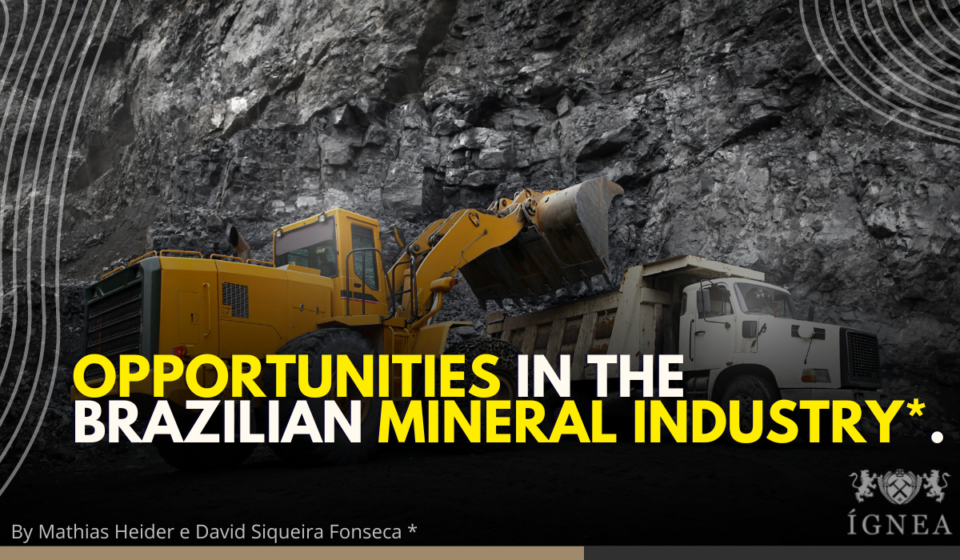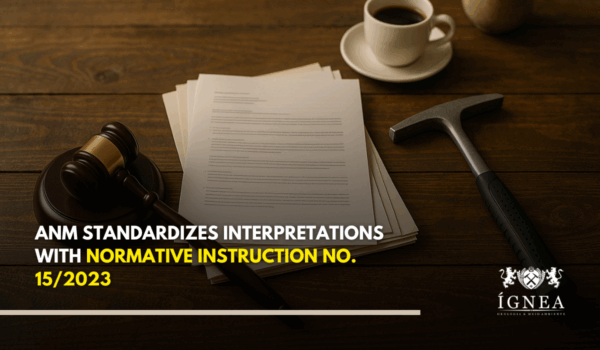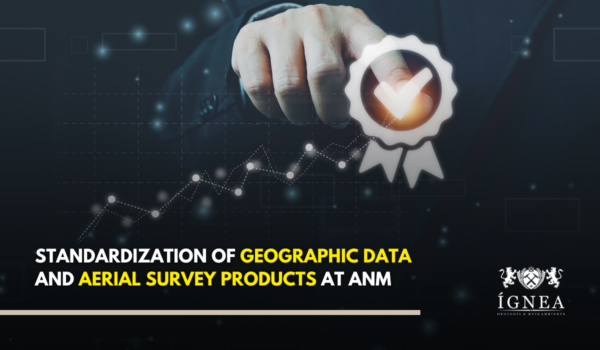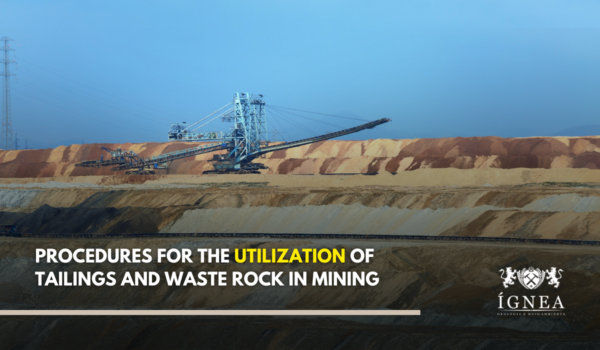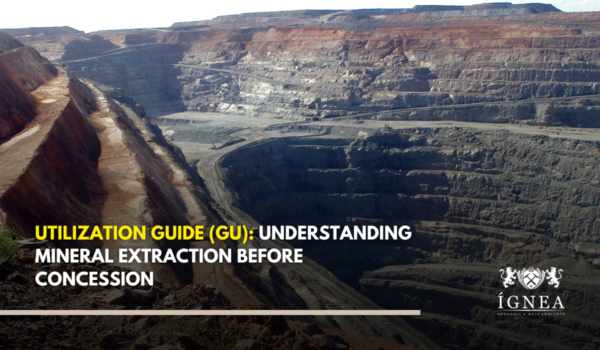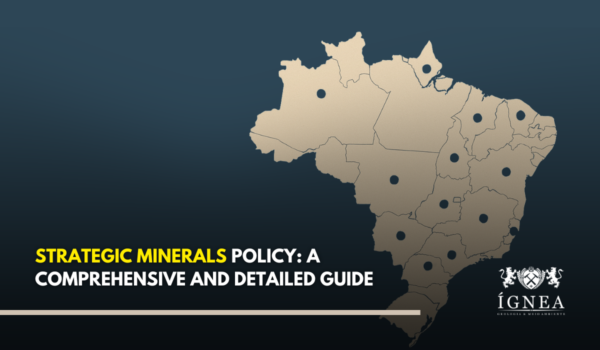The magazine In the Mine published yesterday(16) an article that discusses the main areas of opportunity for the Brazilian mining sector.
The article written by Mathias and David Siqueira Fonseca, experts in Mineral Resources from the National Mining Agency (ANM), details the innovations to face the challenges of mining and points out promising areas of the Brazilian mineral scenario.
Below, we have separated the article in its entirety from the experts:
-
Introduction
The rapid and constant evolution of the consumption of mineral commodities by society due to the demographic explosion, new technological standards and demands for quality of life, represent a huge opportunity for the mineral sector, the basis of all production chains.
New mineral substances are added to the productive processes, with expressive improvement in performance and results. To meet this growing and differentiated rhythm of consumption and, furthermore, to ensure its continuous supply, the identification of new deposits becomes a fundamental condition for the sector.
In this context, the mining industry needs to redefine its strategy and find innovative approaches to old problems, and clearly demonstrate that mineral products can be delivered in an efficient and sustainable way.
Thus price volatility, substitution threats, new uses and changing demands must be carefully monitored.
The existing challenges (see article “Challenges and Risks in Mining, In The Mine Magazine, Issue 98), namely the increase in production costs, reduction in ore quality (lower contents and more complex geology), shortage of labor, supply and demand shocks, depletion of global reserves and new mineral applications focused on energy efficiency, are factors that compose a promising scenario and point to opportunities with attracting investments and improving the business environment in the Brazilian mineral sector.
-
Opportunities
2.1 Area Auctions
The procedure for placing titles in availability of area carried out in the past proved to be an obstacle due to its slowness and subjectivity, leading to a huge procedural liability in ANM (National Mining Agency) and endless legal disputes.
The new public offering and auction model, implemented as of 2020, represents an innovation that has already put more than 6,000 titles on the market, with the possibility of attracting investment in research and mining, with the generation of jobs, income, and new projects.
After five rounds, the prospects for the next auctions are quite encouraging, with areas that already have geological knowledge, which reduces the risk of future investments required in mineral exploration.
Thus, even if the area requires a new study or continuity of research by the new buyer, the previous analysis of the mining process can already indicate resources and reserves (in cases where there is a final research report – RFP presented or even approved and a pre-feasibility study).
Note that, besides the auction of ANM areas, the Geological Service of Brazil (CPRM) also has assets that are being divested and auctioned to the private sector, through the Investment Partnership Program – PPI, of the federal government, opening new mineral opportunities, as was the case of the Polymetallic Project, in Palmeiropólis (TO).
The Companhia Baiana de Pesquisa Mineral – CBPM also carries out public bids for areas for mineral research and, in the case of those with more detailed mineral reserves and resources, for leasing to companies, considered a successful model for promoting mining activity in Bahia.
2.2 Continental Shelf
Brazil has an extensive strip of maritime continental shelf, with potential areas already identified. The Ministry of Mines and Energy – MME and the SGB/CPRM are developing policies for their future use, also ensuring the national sovereignty of these resources.
An example of potential to be mentioned is the marine limestone (Lithothamnium), in Maranhão and Espirito Santo, with the possibility of use in several production chains (food, feed, environment, fertilizers) and adding value at a low cost.
2.3 Lower Volume and Low Content Deposits
Given the difficulty in identifying large volume, high content mineral deposits, the option to use smaller volume, low content mineral bodies is becoming more attractive.
Furthermore, the prices of mineral substances have been rising with the lower supply and the growth in demand, in addition to the future exhaustion of world-class deposits.
As an example, we cite the situation of manganese, with the proximity of the exhaustion and/or useful life of several large mines in operation. Brazil has a critical scenario of becoming an importer of this mineral good, if there are no integrated actions to reverse this situation.
2.4 Use of Rejects and Wastes
The use of tailings and waste rock, already with several successful practices in Brazil (iron ore, manganese, aggregates, rock, lithium, etc.) is an increasingly consolidated practice, regulated by Resolution ANM 85/2021.
In the case of smaller iron ore mining companies, which only produce pellets and sinter feed, there is potential for extraction of the pellet feed deposited in tailings dams.
In addition, several companies are technologically characterizing their tailings and waste rocks to assess their potential for use in stone-making, or to allow the use of other mineral substances, such as Largo, which produces vanadium and will use titanium.
Another practice to be encouraged is the disposal of ore with lower content (below the cutting content) in specific piles (marginal ore) for future use.
The most significant case was the use of lower grade compacted itabirites by Vale (Itabiritos Cauê I and II, Conceição and Vargem Grande Projects), for the production of pellet feed, maximizing the use of the mineral resource, besides benefiting the local population with the extension of the mine’s useful life.
2.5 Circular Economy
The circular economy is another trend that is increasingly present, involving the entire production chain, and the participation of the academic sector is fundamental to maximize this opportunity.
As an example, we cite the use of aluminum and lead scrap in Brazil, which is a world case study to be highlighted. There is also the use of phosphogypsum from the productive chain of phosphate and zinc metallurgy, with great regional scope, favoring the reduction of environmental liabilities and revenue generation.
It is also worth noting the use of slate refuse, in the form of rock and inputs for the cement industry.
The recent initiative of several iron ore mining companies to separate the silica from their waste and produce aggregates is also a great advance, reducing the generation of environmental liabilities.
On the other hand, it should be noted that the recycling of electronic scrap and civil construction waste is still incipient, but with high potential.
2.6 Reactivation of Paralyzed Mines and/or Reevaluation of Reserves
Another opportunity for the sector is the reactivation of inactive/”exhausted” mines (Riacho dos Machados, Santa Luz, etc.), with the reassessment of the reserves and their technical and economic viability.
One should also consider the possibility of taking advantage of the remaining resources and reserves through underground mining, after the exploration in open pit mining is completed.
Kinross is mentioned, which practically tripled its annual gold production and increased the useful life of the Morro do Ouro Mine, in Paracatu (MG), with a bold project to reassess its reserves.
Vallourec Mineração, which initially only mined the hematite body, started to mine the itabirite and to use its tailings, increasing the production of its pellet plant (about 1.4 Mtpa of pellets) that supplies the company’s steel mill in Jeceaba (MG).
2.7 Mergers and Acquisitions
Since the 2000s, a strong trend of mergers and acquisitions of mining companies and their mining assets has emerged, in addition to the internationalization of the sector, with new companies entering Brazil and acquiring mining companies and assets abroad.
Vale began an ambitious and successful program of acquisitions of mining companies such as Samitri/Samarco, Ferteco, MBR, Socoimex and, later, INCO in Canada, among others.
In addition, it sold assets such as Kaolin, Gold, Bauxite/Aluminum and Phosphate (acquisition from Bunge Fertilizantes and sale to Mosaic).
There has also been a movement to identify undervalued mining assets, with potential to increase reserves and/or the price of mineral assets, adding synergies and new operational models, market gains or even the incorporation of assets outside the strategy of some companies (reserves and mining assets of lower volume/shipping, for example).
The recent purchase of Ferrous by Vale aimed to increase the production of pellet feed to supply its pelletizing plants in Tubarão (Vitória/ES), despite its smaller size.
Also, there are several situations in which the mineral reserve allows certain projects to be resized (for example, incorporation of contiguous areas), with higher production and lower cost.
Currently, the companies focus on a better quality of capital allocation and reduction of the risks involved, qualifying their acquisitions according to a strategic orientation and careful portfolio analysis.
Cases of success and failure in mergers and acquisitions have brought many lessons, maturing the sector. Yamana started its operations in Brazil having several production units. Today, it maintains only Jacobina Mineração, in Bahia and was recently sold to the South African Gold Fields for about US$ 6.7 billion.
2.8. Stock Exchange and Junior Companies
The implementation of a mining stock exchange in Brazil, following Canada’s example (Toronto Stock Exchange Venture – TSXV) and the incentive mechanisms for mineral research represent a huge opportunity for the mineral sector and have been discussed for many years.
In 1972, Canada introduced flow-through shares (FTS) in its Income Tax Act. It is a complex operation, requiring changes in laws and regulations, but if implemented in Brazil, it can have a very positive impact for the mineral sector, also aligning it with international best practices.
In the wake of the stock exchange of mining assets, the Junior Companies have emerged and should be strengthened, for their fundamental role in the discovery of new deposits, as in the case of the Aripuanã zinc project, in Mato Grosso, the Tocantinzinho and Volta Grande gold projects, in Pará, and Mara Rosa, in Goiás, and the Ponto Verde iron ore project, in Minas Gerais, among others.
The performance of the junior companies and the progressive reduction of risk promote value to the shares of these companies, besides regulating and making transparent the disclosure of reliable results and the permanent search for new projects.
The sector is known for its efforts to create a stock exchange focused on venture capital for mining in Brazil.
2.9 Resolution of Conflicts and/or Greater Use of Areas (dismemberment)
It is important to remember that the former National Department of Mineral Production (DNPM) started the procedure of coexistence of mining rights over the same area, with dismemberment according to a certain depth of each title.
A successful example is the dismemberment of a mining title for coal in Morro da Fumaça (SC), where the Cooperative of Mineral Exploration (Coopemi) extracts clay (in the form of cooperative mining) for use in ceramics to a certain depth with the support and supervision of the ANM/SC.
Currently, the subject is on the second Regulatory Agenda (2022/2023) of the ANM (on the Indicative Agenda), but it has everything to enable new projects to be started.
In addition, total or partial cession processes of titled areas can contribute to the greater production of mineral goods where supply is more critical (aggregates, clays).
2.10. Critical Minerals
The list of critical minerals in Brazil was defined by Resolution No. 2, dated 06/18/2021, of the SGM/MME (Secretariat of Geology, Mining and Mineral Transformation, under the Ministry of Mines and Energy).
The strategies and policies of countries with regard to critical minerals seek to meet current and future demands, according to their economic, technological, defense, and even health interests.
They represent a response to increased international competition to meet technological and green economy innovations and reduce their geopolitical vulnerabilities/risks, with China’s current broad dominance in these production chains.
To emphasize, the critical minerals of the energy transition alone may reach a demand of $400 billion by 2050, showing their potentiality for mining companies.
Brazil has opportunities for several critical and strategic minerals, fundamental to the competitiveness of the U.S. and European Community industry and to the continuity of its technology industries and green economy.
The continuity of the work of the SGB/CPRM with sectorial diagnoses is an important action to allow the development of new projects.
It is worth highlighting the RD&I work developed by the private and public sector through their own research and innovation hubs, along with state and federal technological research agencies such as CETEM, IPT, CERTI Foundation, CODEMIG and others (MCTI, ABDI etc.).
In the line of research and technological development, the highlights are lithium, rare earths, graphite/graphene and uranium (the latter with recent and important regulatory changes in Brazil).
2.11. Remineralizers (Rochagem)
After the academic studies started in the nineties of the last century, which aimed at the use of waste and mining tailings in agriculture, remineralizers have acquired new importance today.
Several areas of these mineral assets are being explored, aiming at the continuous improvement of soils, through tests in several cultures, with the support of EMBRAPA (Empresa Brasileira de Pesquisa Agropecuária).
Regulation began in 2013 with Law No. 12,890, which included remineralizers as a category of input intended for agriculture. The law was regulated by Decree No. 8,384 of December 29, 2014.
Examples are the kamafugitos from the region of Patos de Minas (MG) and Montes Claros de Goiás (GO), which have satisfactory levels of potassium; the phosphate rocks of Bambuí, in southern Tocantins; the flogopitites from emerald mining; the shales (GO and BA); and the phonolite, in Poços de Caldas (MG), among many others, which can be mixed to obtain products that enhance soil improvement.
Several larger mining companies evaluate their waste rock and tailings to estimate their potential for stone setting.
2.12. Energy Crises in Europe
The war in Ukraine showed the serious fragility of countries dependent on external energy supplies that, besides the geopolitical risk, suffered the inflationary impact of its price and production cost (mining/metallurgy), including increasing environmental impact with greater use of energy from coal.
Brazil, again, has a privileged position in the matrix of clean and renewable energy, being able to gauge a great economic and strategic advantage, besides the lower cost of production (wind and solar energy).
In this context, the Northeast of Brazil emerges with enormous potential, and can attract energy-intensive metallurgies, such as aluminum and other alloys, with integrated projects “Metallurgy and Energy Production Unit”, taking advantage of the lower cost of distribution and the reduction of energy losses in transmission, besides the reduction of CO2 emissions.
2.13. Investir mineração
It is a network of focal points, formed by representatives of public agencies and institutions and private entities, which aims to promote conditions that favor the financing of mining in Brazil.
Through the exchange of experiences and the sharing of best practices, the forum aims to contribute to the improvement of the business environment in the sector in the country, expanding and diversifying the mineral production and enabling a larger number of companies to operate in the sector by promoting a culture of investments in mining and raising funds in capital markets, besides suggesting regulatory improvements (https://investmining.com.br/).
-
Final considerations
Mining has an increasingly prominent role in strengthening the Brazilian economy and maximizing the benefits for all of society.
The identification of opportunities for the mineral sector and their implementation is a growth and dynamization factor with great return. The improvement of the mineral and environmental legislation and its application/interpretation is a critical factor.
The legalization and formalization of the mineral activity and the future use of mined areas are important points for the strengthening of the mineral activity, reducing the impact of contrary actions by several interested parties (stakeholders).
Several large projects suffer delays in their implementation, leading to legal insecurity for the sector, with strong opposition from several stakeholders (see article “Challenges and Risks in Mining”, In The Mine 98 Magazine).
Brazil is developing its infrastructure planning, which will make several mineral frontiers feasible (North of Minas Gerais, interior of Bahia, Tocantins, Piauí, Mato Grosso etc.) and provide competitiveness with railroads and ports, also benefiting other sectors such as agriculture.
The update of the Mining Code and the regulation of mining in national forests (Flonas) and quilombola areas is another important issue to open new opportunities for the mineral sector, bringing legal security.
On the other hand, adherence to “ESG” (Environmental, Social and Corporate Governance) standards and decarbonization actions are increasingly rooted in the mining sector.
It is no longer an optional or differential aspect: it has become the minimum operational standard for mining companies to operate, as required by various stakeholders, who are increasingly active.
Well-established social licenses, responsible investments, community relations, and transparency will be essential for the success of mining projects, leading to sustainable results that generate value and growth.
The scenario of Brazil’s insertion in the Organization for Economic Cooperation and Development – OECD represents a huge advance in economic and public policies with the adoption of market economy rules, attracting investments and project financing with lower interest rates.
The improvement of the ANM regulatory process, besides bringing predictability, transparency and legal security to the sector, is also a strong investment attraction, associated with the improvement of the mineral sector’s public governance.
Many companies and financiers have made it imperative to report the “environmental” and legal footprint of products throughout the value chain and take steps to reduce their carbon emissions, with implementation of new technologies, such as blockchain, for tracking production.
Each mining company is responsible for improving the trust it builds in relationships with its stakeholders and strengthening the mining social license to operate.
The joint action of the public and private sectors is essential for the strengthening, convergence of actions and sustainability of the sector and for maximizing the use of mining opportunities in Brazil.
Original Text: https://www.inthemine.com.br/site/oportunidades-do-setor-mineral-brasileiro/
Bibliographic References:
https://www.cprm.gov.br/publique/Recursos-Minerais/Projetos-Especiais-e-Minerais-Estrategicos-203
https://pt.institut-seltene-erden.de/die-us-politik-im-umgang-mit-kritischen-mineralien/
https://www.pwc.com.br/pt/estudos/setores-atividade/mineracao-e-siderurgia/2022/mineracao-2022.html
https://www.ey.com/pt_br/cem/construindo-competitividade-a-longo-prazo-no-setor-de-mineracao-
https://www.ey.com/pt_br/cem/construindo-competitividade-a-longo-prazo-no-setor-de-mineracao-

